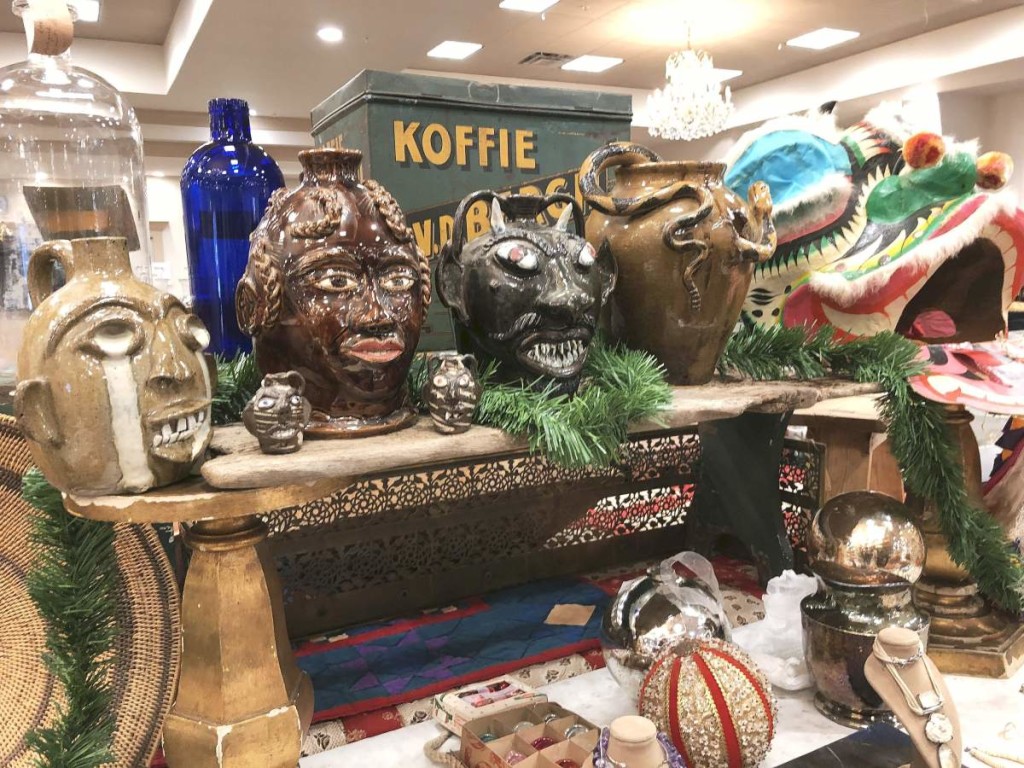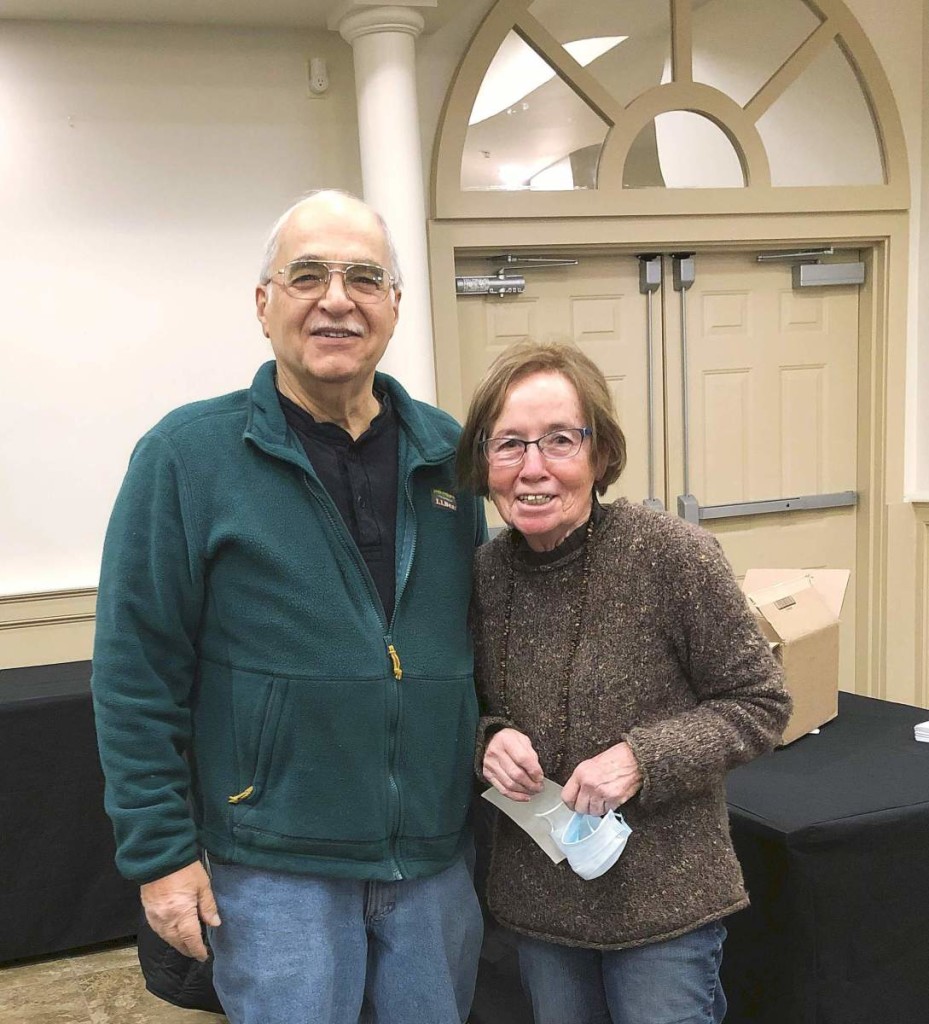Review & Photos by Rick Russack
PORTLAND, MAINE – The December 12 show was the first of five that Liz and John DeSimone’s Goosefare Promotions has scheduled at Portland’s Italian Heritage Center. There were more than 30 dealers set up in the facility, which allows easy access for exhibitors to load in and out. Several dealers commented that they liked the well-lit, carpeted venue. The parking lot was overflowing and patrons were still coming in nearly two hours after the show opened. It was scheduled to be a four-hour show, 10 am to 2 pm, with free admission after 1 pm, designed to attract a younger crowd. The DeSimones said the free admission has worked well for them at some of their other shows and “it definitely brought in younger buyers.” More and more show managers are saying the same thing.
Furniture ranged from a formal 1780s armchair to a set of four fancy painted chairs, to primitive pieces. There was jewelry, a booth full of nothing but Christmas items, trade signs, early maps, face jugs, hooked rugs, Midcentury Modern ceramics and enamels, stoneware, redware, ironstone, painted woodenware, etc. There were also numerous items not easily categorized, such as what appeared to be futuristic aluminum “spacemen,” a broadside for the 1811 hanging of a murderer and more.
Just down the aisle from the admissions table, one couldn’t help but notice two large aluminum figures made from a variety of objects that might have been said to be spacemen – or they could have been anything you’d like to call them. They were in Don Heller’s booth, and he said they had probably been made in the 1970s. Heller said they would each light up and had been made by a freethinking artist, Jim Bauer, who lived in Maine. The smaller of the two was holding an aluminum rolling pin in his hands, which was made of regular dinner forks, while the larger one looked ready to take on any terrestrials that wanted to do battle. Heller was asking $1,850 for each. He also had a large painted birdhouse that would accommodate 24 martin families. The asking price for that was also $1,850. His booth also had a selection of the early furniture he usually displays.
Staying with Twentieth Century items, John Hunt Marshall, Florence, Mass., usually has a selection of colorful midcentury enamel wares by Norwegian company Catherineholm and pieces by other Scandinavian makers. According to Marshall, the prices of the popular Cathrineholm lotus pattern pieces depend on the color and size. He said avocado-color pieces are the most common and pink is the rarest. He also noted that condition is important – flakes will definitely reduce the value. The style was introduced in the 1960s. His prices for the selection at the show ranged from $110 for a small bowl to $850 for a large, scalloped platter. Danish enamelware is usually of a solid color and often attracts a different collector.

Catherine Jane Leuthold, GHG Antiques, Waldoboro, Maine, offered a selection of face jugs. Hers dated from the 1970s to 2000 and were priced between $500 and $1,000. She has collected them for years and said that supposedly the faces were intended to scare children away from the liquor the jugs contained. She also said the miniature ones are scarce and priced them $400/500. The snake jug was $1,200.
There was plenty of traditional Americana. Brian Cullity, Sagamore, Mass., had a circa 1780 North Shore Chippendale armchair, which he priced at $950. He said, “I really like it. It has a carved rest, carved knuckles and a well-carved splat. I’ve lived with it for a while. If it doesn’t sell, I don’t mind living with it for a while longer.” Cullity also had early American silver, early glass and a selection of Liverpool jugs. Bob Markowitz, Groveland, Mass., had a set of four fancy side chairs with painted landscape scenes on the crest rail and decorated splats. Markowitz said that he believed the set was made in New York or Connecticut and compared them to a set of six similar chairs owned by Colonial Williamsburg and dated as circa 1820. He priced the set at $1,450, and the next day said, “I thought I had them sold, but now I may keep them until next summer’s New Hampshire shows.” He also had a very interesting mid-Nineteenth Century miniature, or salesmen’s sample classical style sofa with heavily carved arms. It was very similar to one illustrated in Schiffer’s Miniature Furniture. The asking price was $975. Bruce Trumper, Belgrade, Maine, offered a primitive tavern table with a two-board top for $425, and there were other small pieces of furniture in several booths.
One of the unusual items was a rare broadside, Lines Written on the Death of Ebenezer Ball, by Jonathan Fisher and printed in 1811. Ball was convicted of murdering John Tillitson Downes. Today, we’d probably think of Ball as a career criminal who was being sought for counterfeiting. Downes was an officer pursuing him and was shot and killed by Ball. He was apprehended, convicted of murder, and was the first man hanged in eastern Maine. Executions were public affairs in those days. The broadside was owned by Steve Hanley, Bickerstaff Books and Maps, Scarborough, Maine, and was priced $9,000. Only 200 copies of this, the second edition, were printed, and very few are known to exist. A slightly earlier edition comprised 400 copies. Jonathan Fisher (1768-1847), who wrote the broadside, was the first settled Congregational minister of the village of Blue Hills, Maine. Fisher was also an artist, farmer, scientist, mathematician, surveyor and writer of prose and poetry. His home in Blue Hills is now a museum.
A few days after the show, John DeSimone said that he and Liz thought it went well. “Attendance was strong throughout and we’re very pleased with the gate,” he said. “A few of the dealers told us that they had a good show. I think it was simple for everybody, and the four-hour format worked. The facility was a good one, and the location was easy to find. We’re looking forward to the four more we have planned at the same location next year.” For the last few years around this time of year, until Covid regulations came along, Goosefare had promoted a large show with room-setting booths at Portland’s Thompson’s Point event center. That show will be back in 2022 in the Portland Expo center and then back to the original location. Goosefare also produces about a dozen other shows, ranging from Cape Cod to Maine. For information, 800-641-6908 or www.goosefareantiques.com.























